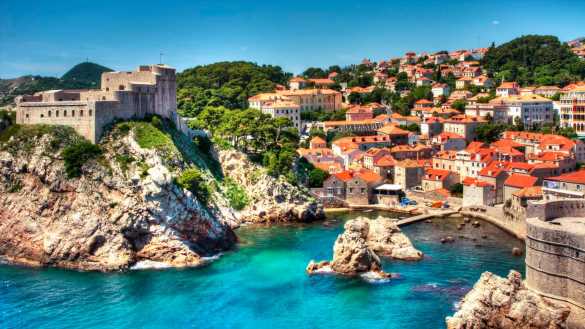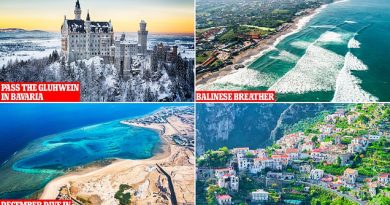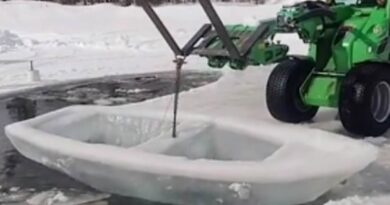This Tourist Hotspot Is Open—and Blissfully Quiet
The term overtourism could’ve been coined for Croatia: a phenomenon discussed a heck of a lot pre-pandemic when global tourism seemed to have reached an all-time saturation point. A record 21 million tourists visited Croatia in 2019, which was a 5 percent increase on 2018. Bearing in mind Croatia’s total population is a humble 4 million and that its coastal cities are tiny, 21 million was more than a lot; it was tourist-swamped hell.
Cruise liners were a major culprit, as was the popular television series Game of Thrones which was predominantly filmed in Croatia. Whatever we choose to blame, the thin cobbled streets had become as intense as the New York subway in rush hour. Cut to 2021 and it’s a different story. It’s a balmy, golden summer and while things are optimistic as tourism relaunches in earnest—it isn’t even close to hectic yet. Guides and hoteliers estimate the numbers to be 30 percent of their former glory, which means a blissful state of affairs for travelers.
Essentially, this is your last chance to catch these iconic destinations before the legions and liners return, so here’s a flavor of what Croatia’s like right now.
In years past the advice from travel articles for Dubrovnik was simple—don’t come in the summer months when it’s unpleasantly crowded. For scale, only 500 local residents still live in Dubrovnik’s old town, the rest of its warren of buildings are Airbnb lets or hostels.
Nowadays the apartments of the beige stone-walled city are but moderately occupied and crowds are sparse. Lanes that were once gridlocked now make for a blissful day of meandering and church bells resonate down the half-empty streets. Its heavenly beaches, such as Banje, Dance, and St. Jacob’s, are the true stars of Dubrovnik and have plenty of space to lounge on these days. The best restaurants around will gladly find you a table. Easily the best time to visit in aeons.
Plus, United Airlines launching a direct flight from Newark that whisks you to the jewel of the Adriatic in a cool nine hours, it’s never been easier—and it certainly hasn’t been this safe and peaceful a peak season for years.
Another victim of over tourism was Croatia’s oldest and largest national park, Plitvice, famous for its insanely beautiful lakes of the most ethereal azure blue you’ve ever seen. Sixteen lakes full of calcium carbonate and travertine cascade into each other by means of waterfalls of all shapes and sizes. Its popularity pre-COVID saw the designated pathways so rammed-full of visitors that walking them was taxing, as the jostling of pushy tourists would take your attention away from the park’s stunning beauty. There used to be queues to take photos in front of certain waterfalls that stretched back 400 yards, but not today. Now it’s a dreamy day out, particularly if you’re the sort who vibes off spending the day in magnificent natural surroundings. The park’s eight looping paths are easy to traverse, the boats across Lake Kozjak are easy to board, and those all important pics are easy to snap.
Favorite with the yacht set, the oldest coastal town founded by Croats, Sibernik, is a delightful spot built in an alcove where river meets sea. It’s long been popular with all manner of international tourists who frequent its pretty old town and top restaurants, as well as using it as a base for island-hopping and visiting the three neighbouring national parks, Krka, Kornati, and Plitvice. The thin step-laden lanes of Sibernik’s old town were packed with pedestrians and tour groups circa 2019, but now those Renaissance streets are transportative, a picture of elegance and serenity. Famous local restaurants such as the seaside More, chic Pelegrini and the town square’s Gradska Vijecnica are still serving the best fare in town but now you can get a table with comparative ease and enjoy the tranquility as you watch the sun set over the bay.
Famous for its divine aquamarine waterfalls, Krka National Park is a short drive from Sibernik or Split and is a Croatia must-see. Instagram made the park’s Skradinski Buk falls famous and the visitors followed, approximately 1.3 million of them in 2019, an all-time high for Krka. Google Krka and you’ll likely see people swimming in the pools with the waterfalls crashing down behind them, but due to the overwhelming swell of tourists, the park made the executive decision to stop bathers in Skradinski Buk to save the ecosystem and put health and safety first. Wise. These days the park is still busy—they had 400,000 visitors in 2020 despite the pandemic—but with the bathers gone and a diminished tour group crowd, it’s alive with a vibrancy and excitement that makes for a gorgeous day out. Visit as soon as possible while the going’s good.
Party central, Split, is arguably the busiest place in the country right now but it’s still chill compared to how it might normally be. One of the most unusual town centers in the world, Split’s beating heart is its old town that was founded within, and later spilled out of, the four walls of the Roman Emperor Diocletian’s palace, built in the fourth century A.D. The bars of the walled palatial city, its surrounding Venetian squares and seaside promenade, known as the Riva, have been heaving with tourists for years, and the quest to find a table stumped many. Now you can take your pick of watering holes and enjoy cocktails or excellent local beers and wine with no stress at all. The late night scene is a big mood, as Split’s student population and local residents go hard until the small hours, tourists or no tourists. You can join them at beachside haunt Tennis or cavernous Disco 305 AD where you’ll likely be asked to show your vaccine card on entry. Take note, the gargantuan cruise liners have returned to this maritime town, but in a fraction of their former domination, so walking the ancient streets now is manageable and magical.
Capital city Zagreb is one of the cheaper destinations in Croatia. Unusual for a capital sure, but its lack of beaches sees Zagreb less packed than its coastal counterparts and so the prices are resoundingly reasonable here. That’s not to say this charming city isn’t without appeal. It’s attractions always pulled in a fair share of tourists, from the Museum of Broken Relationships to swimming in/partying around the buzzy Jarun Lake or, for the intrepid, exploring the city’s wealth of abandoned buildings; the unusual sights kept the visitors coming. They’re returning slowly but in a streamlined fashion so you can join city walking tours and practically have the guide to yourself, then take your pick of fine dining along the restaurant road, Tkalčićeva Street. Zagreb is all yours right now.
There’s no fearmongering here. Croatia is completely geared up to receive its millions once again and return to its former top spot on the 21st century European grand tour. The Tourism Board’s catchy but truthful slogan “Stay Safe in Croatia” rings loud and proud, with all hospitality workers being vaccinated as a matter of course and entry restrictions being firm but fair (vaccines or negative tests or a recovery doc for entry). The aim is to pull back in North American and European tourists as soon as possible for a virtually mask-free, glorious summer holiday that makes one forget there’s even a pandemic on at all. Beat those imminent crowds and get to Croatia before it’s overrun again.
Read more at The Daily Beast.
Source: Read Full Article



